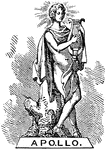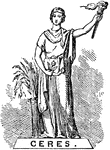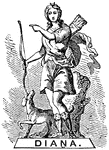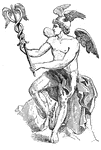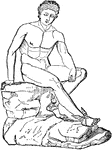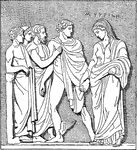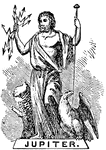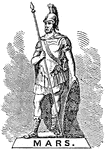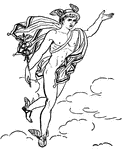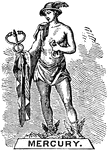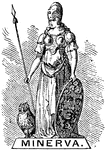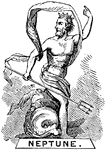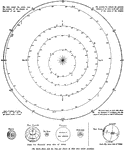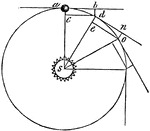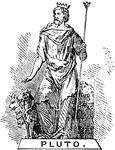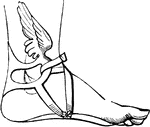
Air-Pump
"This was invented in 1865 by H. Sprengel. The instrument, in its original (simplest) form, consists…
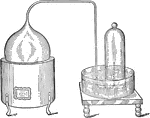
Lavoisier's Apparatus
An apparatus used by Lavoisier to heat mercury (Hg) so that mercury oxide (HgO) could be obtained.

Barlow Apparatus
"A current is caused to pass from the mercury through C along the radius of the disc A through the field…
Barometer
"A Torricellian tube, firmly fixed to an upright support and properly graduated, constitutes a mercurial…
Barometer
"A glass tube about 33 inches in length, open at one end, is completely filled with mercury, and being…
Barometer
"A cistern barometer, being that generally seen in weather-glasses or ordinary barometers. The tube…

Barometer
"...being merely a tube of glass, nearly filled with mercury, with its lower end placed in a dish of…
Barometer
"Measures atmospheric pressure. Pressure from the atmosphere compresses the mercury in the tray forcing…

Mercury Barometer
"Mercury enclosed in a tube inverted and inserted into a bath of mercury can serve as a measurement…
Barometer Measuring Pressure of a Partially Evacuated Vessel
"The degree to which the air has been exhausted from a closed vessel in which there is a partial vacuum…

Capillarity
Capillarity. On the left, water is higher in the smaller tubes due to adhesion. On the right, mercury…

Capillary Attraction
"b is a glass tube in water and c is a glass tube in mercury. The surface of the water in the tube b…
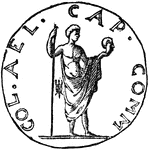
Coin of Hostilianus
A coin of Hostilianus, with a figure standing with a blunt spear in his right hand and a human head…
Compressed Air Manometer
"The compressed air manometer consists of a strong graduated glass tube of uniform narrow bore, closed…
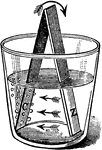
Current Electricity
"Take the zinc from the tumbler of acid and, while it is yet wet, rub thereon a few drops of mercury...replace…
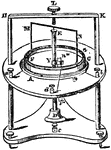
Electric Apparatus
"ABC is a horizontal coil of wire terminating at the binding screws a, b. FG is a ring-shaped trough…
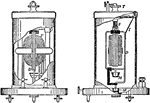
Siemens Electrodynamometer
F, fixed coil; D, movable coil; S, spiral spring; T, Torsion head; MM, Mercury cups; I, Index needle.
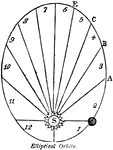
Elliptical Orbit
"The elliptical circle being supposed to be the Earth's orbit, with the Sun, S, in one of the foci.…
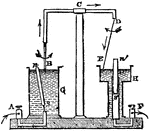
Faraday Apparatus
"This apparatus shows the rotation at once of a magnet and of a movable conductor. The rotating pieces…

Funnel with Inverted Mercury Thermometer
"Pass the tube of an air thermometer or of an inverted mercury thermometer through a cork in the neck…

Hydrometer of constant weight
"As generally made, a hydrometer of constant weight consists of a glass tube near the bottom of which…

Cooper-Hewit Mercury Vapor Lamp
"Alternating current self starting Cooper-Hewit mercury-vapor lamp." —Croft 1917

Cooper-Hewit Mercury Vapor Lamp
"Direct current self starting Cooper-Hewit mercury-vapor lamp." —Croft 1917
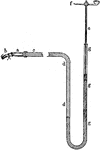
Manometer
"Mercury manometer for recording blood-pressure. d g, glass U-tube partly filled with mercury. In one…
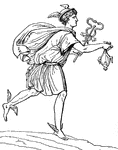
Mercury (Hermes)
"Mercury made haste, put his winged slippers on his feet, and cap on his head, took his sleep-producing…

Mecury Barometer
Illustration of a tube inverted over mercury, with the mercury rising inside the test tube 114 millimeters…
Mercury Tube
This illustration shows the proportions of volume in which hydrogen and oxygen combine by introducing…
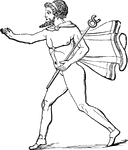
Mercury with caduceus
"Mercury, with his caduceus, summons the souls of the departed from Orcus, or the low world, as in the…
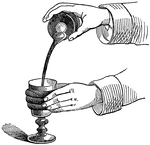
Pouring Mercury
Pouring mercury from one container into another. Mercury is the only metallic element that is liquid…
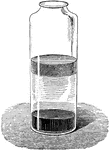
Phial of the Four Elements
Mercury, water, and oil are poured into a glass jar. The mercury goes to the bottom, the oil floats…
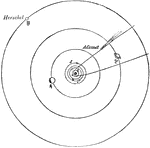
Planet Distance
"Relative distance of the Planets. Having now given a short account of each planet composing the solar…
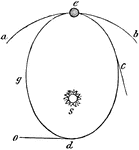
Planet Motion
"Elliptical Orbits.—It has been supposed that the Sun's attraction, which constitutes the Earth's…

Pluto, Persephone, and Mercury
"Mercury was sent, accompanied by Spring, to demand Persephone of Pluto. The wily monarch consented,…
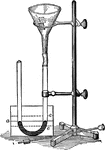
Effects of Water on Mercury in a U-tube
"After pouring mercury into the U-tube, the level of mercury is marked by a. c and e refer to the positions…

Telegraph Sounder
"A variation of the telegraph sounder that uses a pool of mercury to close the circuit to produce the…
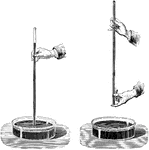
Torricellian Experiment
This experiment showed that every surface exposed to the atmosphere sustains a normal pressure equal…
